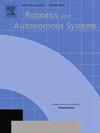通过具有记忆衰减新奇感的分层强化学习实现无地图导航
IF 4.3
2区 计算机科学
Q1 AUTOMATION & CONTROL SYSTEMS
引用次数: 0
摘要
分层强化学习(HRL)在无地图导航任务中表现出卓越的性能。然而,在可能包含长走廊和死角等地形的非结构化环境中,它仍然受到限制,因为这些地形可能导致局部最小值。这是因为大多数基于 HRL 的无地图导航方法都采用了简化的奖励设置和探索策略。在这项工作中,我们提出了一种用于训练高级(HL)策略的新型奖励函数,它包含两个部分:外在奖励和内在奖励。外在奖励鼓励机器人向目标位置移动,而内在奖励则根据新颖性、情节记忆和记忆衰减来计算,从而使机器人能够完成自发探索。我们还设计了一种新颖的神经网络结构,其中包含一个 LSTM 网络,以增强机器人的记忆和推理能力。我们在未知环境和容易出现局部最小值问题的特定场景中测试了我们的方法,以评估导航性能和局部最小值的解决能力。结果表明,与先进的基于 RL 的方法相比,我们的方法大大提高了成功率,最大提高了近 28%。我们的方法有效改善了局部最小值问题的解决,尤其是在基线完全失效的情况下。此外,大量的消融研究一致证实了我们提出的奖励函数和神经网络结构的有效性。本文章由计算机程序翻译,如有差异,请以英文原文为准。
Mapless navigation via Hierarchical Reinforcement Learning with memory-decaying novelty
Hierarchical Reinforcement Learning (HRL) has shown superior performance for mapless navigation tasks. However, it remains limited in unstructured environments that might contain terrains like long corridors and dead corners, which can lead to local minima. This is because most HRL-based mapless navigation methods employ a simplified reward setting and exploration strategy. In this work, we propose a novel reward function for training the high-level (HL) policy, which contains two components: extrinsic reward and intrinsic reward. The extrinsic reward encourages the robot to move towards the target location, while the intrinsic reward is computed based on novelty, episode memory and memory decaying, making the agent capable of accomplishing spontaneous exploration. We also design a novel neural network structure that incorporates an LSTM network to augment the agent with memory and reasoning capabilities. We test our method in unknown environments and specific scenarios prone to the local minimum problem to evaluate the navigation performance and local minimum resolution ability. The results show that our method significantly increases the success rate when compared to advanced RL-based methods, achieving a maximum improvement of nearly 28%. Our method demonstrates effective improvement in addressing the local minimum issue, especially in cases where the baselines fail completely. Additionally, numerous ablation studies consistently confirm the effectiveness of our proposed reward function and neural network structure.
求助全文
通过发布文献求助,成功后即可免费获取论文全文。
去求助
来源期刊

Robotics and Autonomous Systems
工程技术-机器人学
CiteScore
9.00
自引率
7.00%
发文量
164
审稿时长
4.5 months
期刊介绍:
Robotics and Autonomous Systems will carry articles describing fundamental developments in the field of robotics, with special emphasis on autonomous systems. An important goal of this journal is to extend the state of the art in both symbolic and sensory based robot control and learning in the context of autonomous systems.
Robotics and Autonomous Systems will carry articles on the theoretical, computational and experimental aspects of autonomous systems, or modules of such systems.
 求助内容:
求助内容: 应助结果提醒方式:
应助结果提醒方式:


